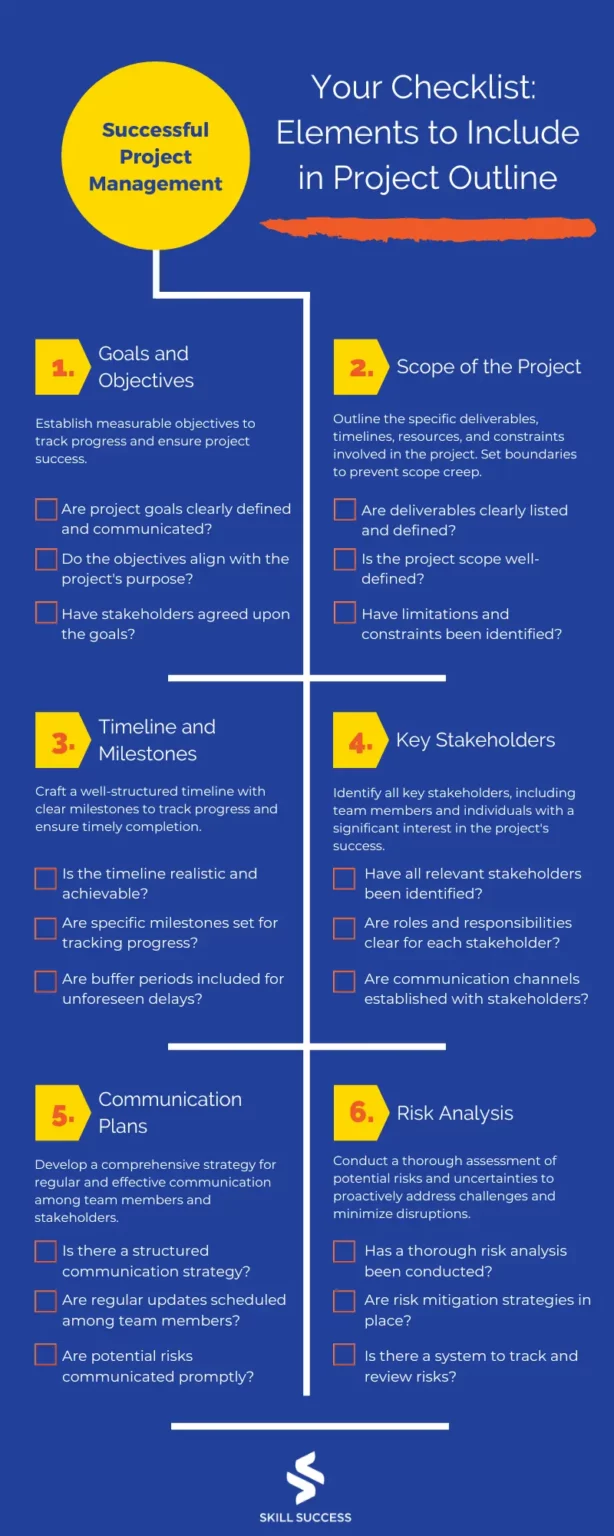
Have you ever found yourself staring at a blank page, unsure of how to begin your latest project outline? Trust me, we've all been there! Starting a new endeavor can feel like wandering through a mysterious maze, without a clear path to follow.
Creating a project outline can be tricky, but it's worth the effort. Learning project management skills, including creating a well-written outline, will help you avoid bottlenecks and ensure that your project is a success
Additionally, I've collected helpful tips from project management experts on the important things to include in your outline. While there are many guides available online, the ones featured in this roundup are based on the real-life experiences of these experts. But before we delve into their advice, let's first understand what a project outline is all about.
What is a project outline?
A project outline is a detailed plan that serves as a roadmap for a project. It acts as a blueprint, guiding project managers and team members on how to execute the project efficiently and effectively. The outline helps ensure that everyone involved is on the same page, minimizing confusion and maximizing the chances of project success.

What to Include in Your Project Outline?
Clear Definition of Project Goals and Objectives
Let's begin with the most crucial aspect: setting clear goals and objectives. While we understand the significance of this step, Donnie Rand, Marketing Coordinator at the American Association of Owner Operators, LLC, has valuable advice that we should all take into account for our next project:
"The most important element of a project outline is the project goal. This section of your outline highlights what you aim to achieve with this project. When you're pitching a new project, you have to explain why the project is necessary. This can include a number of things. A critical part is how the project can benefit the company. Your project goals must be realistic and measurable. Vague goals such as increasing profit must be avoided at all costs."
Donnie also shares his experience on how a clear definition of project goals and objectives helped streamline communication in their projects. He said, "We've worked on numerous projects, and all of them start with a well-curated project outline. Our outline helps streamline communication. When the goals, strategies, and tasks were outlined, there were no misunderstandings. Every team knew what must be done and how."
Additional Tips:
- Use bullet points to organize your project goals and objectives, making them easily readable and accessible.
- Regularly revisit and review your project outline to ensure it remains aligned with the project's progress and evolving needs.
- Seek input from key stakeholders to gather different perspectives and refine your project goals accordingly.
- Prioritize specific and measurable outcomes to keep your team focused and motivated.
Well-Defined Project Scope
A comprehensive project scope enables effective resource planning and allocation. It also acts as a safeguard against scope creep, which refers to an uncontrolled expansion of project scope. It helps project managers identify and manage changes to prevent unnecessary delays and budget overruns.
Ibad Hussain, Head of Marketing at Embedwiz says:
"The project scope outlines the specific objectives, deliverables, timelines, resources, and constraints of the project. It provides a detailed roadmap of what needs to be accomplished, how it will be done, and what limitations or boundaries exist. A comprehensive project scope helps stakeholders understand the project's goals and ensures that everyone involved is on the same page. It also serves as a foundation for project planning, execution, and evaluation, helping to prevent scope creep and ensure project success."
Here are some additional tips from Ibad:
- Get buy-in from all stakeholders before finalizing the project scope: This will help to ensure that everyone is on the same page and that there are no surprises later on.
- Be prepared to adjust the project scope as needed: Things don't always go according to plan, so it's important to be flexible and willing to make changes as needed.
- Document the project scope and keep it up-to-date: This will help to ensure that everyone involved has the most recent information and that the project stays on track.

Timeline and Milestones
An essential component of your project outline is a well-structured timeline with clearly defined milestones. This section breaks down the project into distinct stages, each with specific objectives and due dates.
Sunil Bhuyan, founder of Beingawakened, talks about the importance of having a well-crafted timeline. He also provides valuable advice on the significance of setting clear targets and regularly reviewing progress to ensure successful project delivery.
"When outlining your project, invest ample time in defining a detailed timeline with achievable milestones. Regularly review and update it as needed to maintain focus and keep your team motivated throughout the project journey. Remember, a well-structured timeline enhances accountability and facilitates smooth project management."
Here are some additional tips from Sunil:
- Break down the project into manageable phases with specific objectives and timeframes.
- Involve the team in creating the timeline to ensure a realistic and achievable schedule.
- Regularly review progress and adjust the timeline if necessary to accommodate unforeseen circumstances.
- Celebrate each milestone achievement to motivate the team and maintain momentum.
List of Key Stakeholders
These are not only the team members directly involved in the project but also individuals who have a significant interest in the project's outcome or can influence its direction. Identifying key stakeholders allows you to assign appropriate managers for overseeing progress and decision-makers who can guide the project's course as needed.
Marnix Broer, Co-founder & CEO of Studocu, shares his insightful approach to managing key stakeholders:
"You must identify all key stakeholders, not just the talent that will contribute to the project. That means assigning managers to oversee progress and decision-makers who determine how the project’s direction might shift along the way."
Marnix creates comprehensive lists of every stakeholder and categorizes them based on their functions or roles and responsibilities. This approach allows him to precisely determine the right individuals to include in email communications or approach for status updates and crucial decisions. He ensures that each function has a dedicated team managing it, instilling confidence in the team's ability to handle all project aspects without any oversight or missed opportunities.
Here are some tips for identifying key stakeholders:
- Think about everyone who will be affected by the project, both directly and indirectly: This includes internal stakeholders, such as employees, managers, and executives, as well as external stakeholders, such as customers, partners, and suppliers.
- Consider the project's goals and objectives: Who will be responsible for achieving these goals? Who will be affected by the project's success or failure?
- Think about the project's scope: What are the key activities that need to be completed in order to complete the project? Who will be responsible for these activities?
Communication Plans
Communication plans are often overlooked by some project managers when outlining their projects. Yet, this is a crucial element that should not be underestimated.
Azzam Sheikh, Digital Strategist at Carifex, emphasizes the significance of a robust communication plan in their projects:
"For the project to be a success, there must be a clear strategy for keeping everyone involved in the loop and involved in the process. In order to keep everyone on the same page, the strategy calls for regular communication via email, weekly reports, and online conferences... There will be more openness and responsibility because of real-time updates on job progress made possible by a specialized project management application."
Azzam stresses the importance of keeping all team members and stakeholders actively engaged and informed throughout the project's lifecycle. The goal is to keep everyone aligned and on the same page to foster collaboration and effective decision-making.
Here are some tips for creating a communication plan:
- Identify your key stakeholders: Who needs to be kept informed about the project?
- Determine the best way to communicate with each stakeholder: What methods are they most likely to use?
- Set up a regular communication schedule: How often will you communicate with each stakeholder?
- Create a communication channel for each stakeholder: This could be email, a project management tool, or a dedicated chat room.
- Track your communication: Make sure you are keeping everyone informed about the project's progress.

Risk Analysis
The final, yet immensely important element, is risk analysis. This aspect holds great significance as it helps identify potential risks and uncertainties that may impact the project's success. Chris Stott, Director of Seven Marketing, warns about the consequences of overlooking risk analysis and gives an example:
"Several dangers and difficulties could prevent the project from being completed as planned. For example, bugs in software or incompatibilities with other programs are examples of technological challenges, as can delays in the development and testing processes."
Failure to do risk analysis in a project outline can have serious consequences, including:
- Project delays: If risks are not identified and mitigated, they can lead to delays in the project schedule. This can be costly and frustrating for everyone involved.
- Increased costs: Risks can also lead to increased costs. For example, if a risk leads to a delay in the project, the project may need to be extended, which will increase the cost of the project.
- Project failure: In some cases, risks can even lead to project failure. This is especially likely if the risks are not identified and mitigated early on.
Here are some tips for including risk analysis in your project outline:
- Identify the potential risks: What are the things that could go wrong with your project?
- Assess the likelihood of each risk: How likely is it that each risk will occur?
- Assess the impact of each risk: How much damage would each risk cause if it occurred?
- Develop mitigation strategies: What can you do to reduce the likelihood or impact of each risk?
- Track and monitor risks: Keep an eye on the risks throughout the project and make sure that your mitigation strategies are working.
I hope these expert tips will help you start your project smoothly. Remember, being a good project manager is an important leadership skill to develop.

Other Elements to Include in Project Outline
- Resource Allocation: Plan and allocate resources efficiently to ensure optimal utilization throughout the project.
- Budget Management: Outline the budget for the project and ensure its adherence throughout the project's lifecycle.
- Quality Assurance: Establish measures to ensure deliverables meet quality standards and customer expectations.
- Contingency Plans: Devise contingency plans to address unforeseen events and keep the project on track.
- Team Roles and Responsibilities: Clearly define roles and responsibilities of team members to promote efficiency and accountability.
- Integration with Stakeholder Goals: Align the project's objectives with the goals of stakeholders to enhance project buy-in and support.
- Change Management: Prepare for potential changes during the project and establish a structured change management process.
- Lessons Learned: Plan for post-project evaluation and incorporate lessons learned into future projects for continuous improvement.
Read more: Different Project Management Methods Recommended by Experts

Frequently Asked Questions about Project Management Outline
What is a project management outline?
A project management outline is a detailed plan that outlines the objectives, scope, timeline, and key components of a project. It serves as a roadmap to guide the project from start to finish.
Why is a project management outline important?
A project management outline is crucial as it provides clarity, direction, and structure to the project. It helps in setting realistic goals, managing resources efficiently, and mitigating risks.
How can a project management outline help with resource management?
A project management outline outlines resource requirements and allocation. It ensures that resources are utilized efficiently and that the team has access to the necessary tools and support.
What are the benefits of including milestones in a project management outline?
Milestones in a project management outline provide checkpoints for measuring progress. They help track achievements and ensure that the project is on schedule.
Why should project managers involve key stakeholders in the outline creation?
Involving key stakeholders in the outline creation ensures that their interests and expectations are considered. It fosters a collaborative environment and helps align the project with organizational goals.
Key Takeaways
Crafting a project outline may seem daunting at first, but with the right elements and expert guidance, you can master the art of effective project management.
Follow the advice provided by our experts here in the blog. Use the handy project management outline checklist we've prepared to guide you through the process step-by-step. Embrace the knowledge shared by experienced professionals, and you'll find yourself confidently managing projects like a pro.
For continuous growth in your project management skills and access to a vast library of courses, subscribe to Skill Success All Access Pass. It offers a treasure trove of valuable resources, including comprehensive project management courses to enhance your abilities further.
Embrace the challenge, and you'll soon witness the remarkable results of a well-crafted project outline. Best of luck on your project management endeavors!

